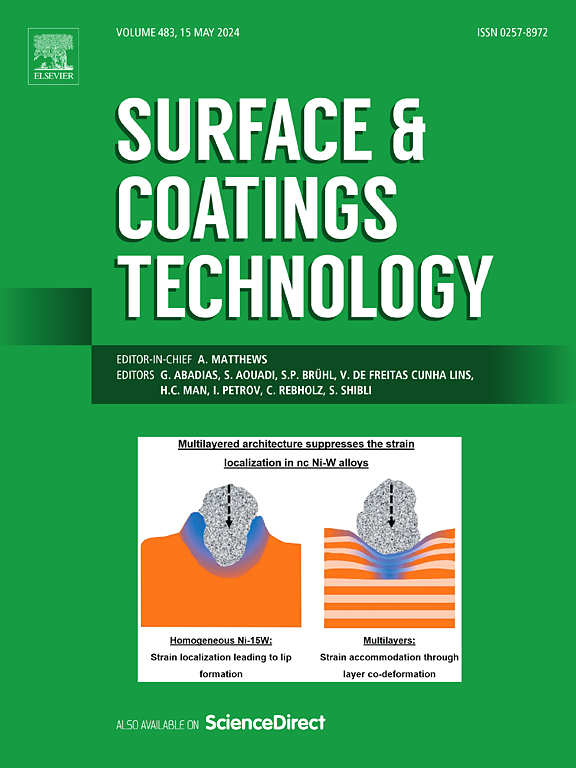Influence of manufacturing route and surface modification on the corrosion behavior of WE43 Mg and Zn1Mg bioabsorbable metallic alloys
IF 6.1
2区 材料科学
Q1 MATERIALS SCIENCE, COATINGS & FILMS
引用次数: 0
Abstract
The use of biometals is becoming more and more popular thanks to the development of new alloys that take advantage of their biodegradability. Due to this beneficial property, particularly Magnesium (Mg) and Zinc (Zn) have been studied frequently within the currently applicable group of bioabsorbable metals. This investigation studied the microstructure, and electrochemical behavior of WE43 and Zn1Mg alloys manufactured by extrusion and Laser Powder Bed Fusion (LPBF), with and without plasma electrolytic oxidation (PEO) surface treatment. The extruded WE43 showed a corrosion rate of 3.42 ± 0.10 mm/year, while the LPBF counterpart has an increased corrosion rate of 11.85 ± 0.14 mm/year. This increase was explained via yttrium oxide particles found in the LPBF material that decrease the protective effect of the corrosion layer, and hence reduce corrosion resistance. For the Zn1Mg, the extruded sample had a corrosion rate of 0.98 ± 0.41 mm/year, whereas the LPBF sample also showed a higher corrosion rate of 2.70 ± 0.09 mm/year. This result was explained by a higher volume fraction of second phase eutectic structure in the LPBF samples, which increased the microgalvanic corrosion between Zn grains and MgZn structures in the eutectic phase. The extruded samples showed thicker PEO oxide layer in both the WE43 and Zn1Mg materials than the LPBF-fabrication samples, and in all cases the corrosion resistance was improved when applying these surface treatments. These findings highlight the impact of evaluating the influence of different manufacturing methods and PEO surface treatments on the corrosion resistance and durability of these biomedical alloys.
制备工艺和表面改性对WE43 Mg和Zn1Mg生物可吸收金属合金腐蚀行为的影响
由于利用生物可降解性的新合金的发展,生物金属的使用越来越受欢迎。由于这种有益的性质,特别是镁(Mg)和锌(Zn)在目前适用的生物可吸收金属群中得到了频繁的研究。研究了采用挤压和激光粉末床熔合(LPBF)制备的WE43和Zn1Mg合金在等离子体电解氧化(PEO)表面处理和不处理条件下的微观组织和电化学行为。挤压后的WE43的腐蚀速率为3.42±0.10 mm/年,而LPBF的腐蚀速率为11.85±0.14 mm/年。这种增加是通过在LPBF材料中发现的氧化钇颗粒来解释的,氧化钇颗粒降低了腐蚀层的保护作用,从而降低了耐腐蚀性。对于Zn1Mg,挤压试样的腐蚀速率为0.98±0.41 mm/年,而LPBF试样的腐蚀速率也更高,为2.70±0.09 mm/年。这一结果可以解释为LPBF样品中第二相共晶组织的体积分数较高,这增加了共晶相中Zn晶粒和MgZn组织之间的微电腐蚀。与lpbf制备的样品相比,挤压后的WE43和Zn1Mg材料的PEO氧化层都更厚,在所有情况下,经过这些表面处理后的材料的耐腐蚀性都得到了提高。这些发现强调了评估不同制造方法和PEO表面处理对这些生物医学合金的耐腐蚀性和耐久性的影响。
本文章由计算机程序翻译,如有差异,请以英文原文为准。
求助全文
约1分钟内获得全文
求助全文
来源期刊

Surface & Coatings Technology
工程技术-材料科学:膜
CiteScore
10.00
自引率
11.10%
发文量
921
审稿时长
19 days
期刊介绍:
Surface and Coatings Technology is an international archival journal publishing scientific papers on significant developments in surface and interface engineering to modify and improve the surface properties of materials for protection in demanding contact conditions or aggressive environments, or for enhanced functional performance. Contributions range from original scientific articles concerned with fundamental and applied aspects of research or direct applications of metallic, inorganic, organic and composite coatings, to invited reviews of current technology in specific areas. Papers submitted to this journal are expected to be in line with the following aspects in processes, and properties/performance:
A. Processes: Physical and chemical vapour deposition techniques, thermal and plasma spraying, surface modification by directed energy techniques such as ion, electron and laser beams, thermo-chemical treatment, wet chemical and electrochemical processes such as plating, sol-gel coating, anodization, plasma electrolytic oxidation, etc., but excluding painting.
B. Properties/performance: friction performance, wear resistance (e.g., abrasion, erosion, fretting, etc), corrosion and oxidation resistance, thermal protection, diffusion resistance, hydrophilicity/hydrophobicity, and properties relevant to smart materials behaviour and enhanced multifunctional performance for environmental, energy and medical applications, but excluding device aspects.
 求助内容:
求助内容: 应助结果提醒方式:
应助结果提醒方式:


